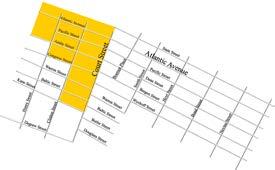HISTORIC PRESERVATION STUDIO II
Affordability Redlining The Federal Housing Administration was established in 1934 to fight against the loss of homeownership due to the Great Depression. The FHA worked with the insurance and banking industries to provide federally insured, long-term, low-interest loans to potential homebuyers. To ensure the security of their investment, the FHA created the Home Owners’ Loan Corporation (HOLC) to set up guidelines. The primary accomplishment of the HOLC was the creation of “residential security maps” in 1935.1 These maps indicate areas that were most likely to receive loans from the HOLC (green zones), to areas that are least likely to receive ones (red zones). The “red lined”areas were usually older districts in the city center, with a substantial presence of minority and immigrant populations. Our study area, including Boerum Hill and Cobble Hill , was coded as a red zone in the 1938 map. Redlining led to low property value and low rental value. In the 1940s, families living in Boerum Hill and Cobble Hill were paying a moderate monthly rental of $30 to $49 (equivalent to $492 - $803 in 2012). During the same period, houses in Brooklyn Heights (color-coded blue), were worth $50 to $99. In comparison, a prime-location apartment near Central Park was worth more than $1502 (equivalent to $2,458 in 2012, or 5 times the price of an apartment in Boerum or Cobble Hill). The devastating effect of redlining on property values continued for about three decades.
Map of Brooklyn
Rent Levels Across NYC in 1940
Source: Brooklyn Community Map 1938, NARA II RG 195 Entry 39 Folder “Brooklyn (Kings Co.)” Box 58, National Archives. http://www.urbanoasis.org/ projects/holc-fha/digital-holc-maps/
Source: Rent Level across NYC based on 1940 Census, Center for Urban Research at CUNY Graduate Center, http:// www.1940snewyork.com/
1 Spellen, Suzanne (2016), “From Redlining to Predatory Lending: A Secret Economic History of Brooklyn,” Brownstoner, March 30, 2016. 2 Rent Level across NYC based on 1940 Census, Center for Urban Research at CUNY Graduate Center, http://www.1940snewyork.com/
A STUDY OF BROOKLYN’S COBBLE HILL & BOERUM HILL NEIGHBORHOODS 121




















